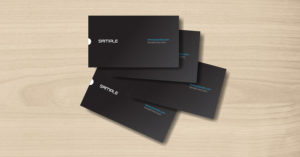
In the business world, at some point you will be asked for your business card. Whether you’re meeting a client, customer, or new coworker, effective business cards are the best way to share contact information for future business relationships.
The most effective business card is an extension of you and your brand. They are designed with your personality and overarching mission in mind. Because business cards are often the first impression someone receives about you and your company, their look and feel matter.
Some Tips on Creating an Effective Business Card
With that in mind, here are some tips from our Safeguard team about how to create an effective business card:
- Consider the shape and size.
There are two main forms of business cards: traditional cards and creative cards.
If you work for a high-powered law firm, say, chances are you want to go with a more traditional card. This card is usually horizontal with square edges. The standard size is around 3.5” x 2”. These cards convey professionalism and expertise.
If you work in a more creative industry, however, perhaps as a wedding planner or an architect, you may want to go with a more creatively-shaped card. These cards come in all shapes and sizes. A wedding planner may have a card cut out in the shape of a bride and groom, for example. These cards convey a sense of innovation and artistry.
- Colors matter.
A business card is a visual representation of you and your brand, which means the colors you choose powerfully convey who you are and what you stand for (https://blog.gosafeguard.com/blog/marketing-with-full-color-printing/). To understand how, it’s important to consider the psychology of colors. Different colors evoke different psychological responses. For example, red evokes a sense of passion or power, while yellow evokes fun and optimism. Not only do you want to choose colors that match your logo and create an aesthetic palette, you also want to choose colors that convey the true sense of your company as a whole.
- Business cards are tactile.
Many people forget that business cards aren’t just visually effective, they’re also effective to the touch. You don’t just look at a business card, you hold it between your fingers and pass it between the palms of your hands. In other words: the texture of your card can convey a subtle psychological message just as much as the colors on your card.
It’s fairly common to use cardstock for business cards because its thickness conveys a high quality. But some, especially those in more creative industries, choose other materials, like recycled paper, bamboo, or even plastic. When considering the material for your cards, again, consider your brand. Are you a flower shop? Maybe you want to try a sheer bamboo paper that is ethereal and light, like a flower petal. Are you an athletic company? A more robust cardstock might be better. Go with the texture that fits who you are.
In need of a fresh business card design?
Our creative consultants at Safeguard are up to date on the latest trends in business card design. They’re experts on the importance of colors, textures, shapes, and more. And they’re ready to learn about your brand to customize the best business card solution for you. Give us a call today for a consultation!